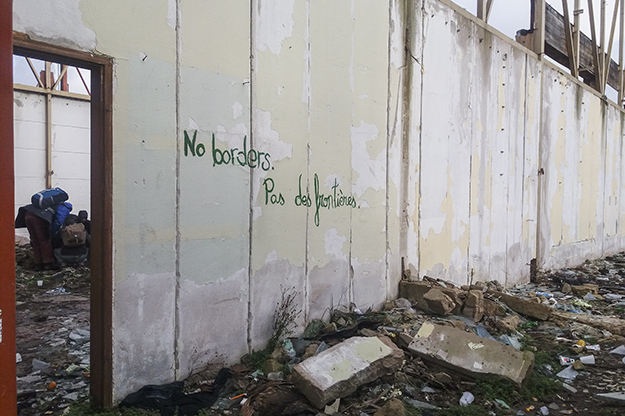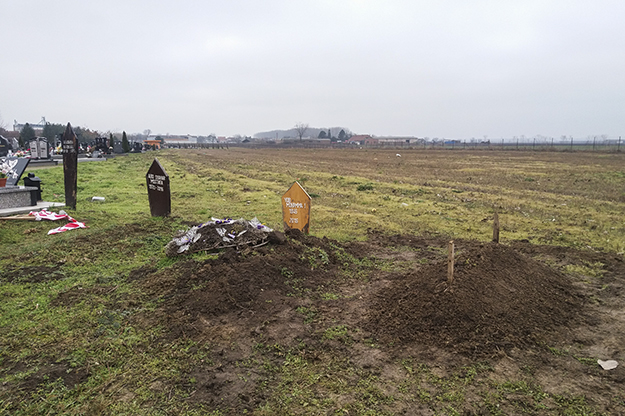Madina was six years old. In the evening hours of Nov. 21, with her mother and four siblings, she crossed an unguarded stretch of the border with Serbia, and entered Croatia. They walked for two or three hours until they arrived at a populated area. Exhausted and frozen, they sat down in the park to rest. As they recall it, it was there they met the Croatian police, who placed the family in a van and drove them back to the Serbian border.
Her mother spoke in vain when she asked the police to at least stay at the station until the morning. In the cold and dark night, together with two men, they were thrown out of the van at the place where the railroad crosses the border.
This is the place known among refugees and volunteers as the point of systematic, often brutal expulsion of the unfortunate people who are denied their legal right to obtain asylum in the Republic of Croatia. It is an active, functioning railroad through which trains run daily.
One of those trains killed Madina. Not far away from the place of the accident, the police, allegedly, watched her die, minutes after ordering the family to walk on the railroad towards Sid.
Madina’s death, one of seven deaths of refugees recorded in 2017 at the Croatian and Serbian border, perhaps could have been prevented if it weren’t for the media silence that has meant stories like these haven’t made it to the Croatian public in the past year.
According to UNHCR data, in the last year, the Croatian police has illegally expelled almost 3,000 people to Serbia. The number of expulsions to Bosnia and Herzegovina and Montenegro is impossible to evaluate.
Among them were families with small children, people with disabilities, women, elderly people, but also men, doubly discriminated against for the cynical idea that they don’t have the right to seek refuge — that they “should have stayed at home and fought,” even though their homes are long gone.
All of them came to Croatia with the hope of exercising their legal right to seek asylum in the European Union. In return, many of them were robbed, beaten, and kicked out onto the very same railroad where Madina was killed.
While you are reading this article, there is a great possibility that the Croatian police are telling somebody: “No asylum for you!” or “Go back to Serbia!” It’s also quite possible that the money or cellphone of that person ended up in the pockets of someone’s dark blue uniform.
The situation is made even worse because the procedure dictates that refugees must seek asylum in the closest police station upon arrival on Croatian territory. In practice, such cases have too often resulted in violent and humiliating treatment, and finally, in illegal expulsion from the country.
Asylum seekers find themselves in a paradoxical situation, where their legal entry into Croatia is forbidden, and their illegal crossing is treated as a crime, even though, according to domestic and international law, it shouldn’t be an aggravating circumstance in seeking asylum.
Even if they manage to cross the border, refugees may not go to the police for fear of being expelled from the state, which pushes them even further from international protection mechanisms, into the hands of smugglers whose network is very strong in the region of the former Yugoslavia.
Attempting to assist refugees in seeking asylum, volunteers started following them in an organized manner into police stations. The presence of volunteer-observers has efficiently mitigated the practice of illegal police treatment, but only in Zagreb, (a city where many never arrive) and at times in other cities where people are ready to spend a few hours arguing with police officials.

In the border area between Serbia and Croatia, near the city of Sid, hundreds of refugees are trying to cross over the border daily and seek asylum in the EU. Photo: Nidzara Ahmetasevic.
Ensuring the right to accessing territory and international protection is the primary mandate of the UNHCR, whose Croatian branch, placed in Zagreb, also followed asylum seekers into police stations. This practice stopped after police officers began apprehending refugees at the very doors of UNHCR building, and from there on expelling them from the country. Police vehicles constantly parked in front of the UNHCR building entrance are now discouraging potential asylum seekers from accessing the international organization.
In the meantime, the UNHCR has transferred the job of informing refugees about the possibility of seeking asylum to the Croatian Legal Center (CLC), who were also tasked with ensuring the availability of international protection mechanisms. CLC’s employees reply to refugees only during regular working hours, even though a large number of potential asylum seekers enter the country during the weekend or overnight, leaving them completely unprotected.
Sealed doors to the EU
The everyday hardships of these people don’t only happen at borders, but also in the center of Zagreb and other cities in the heartland of the country. Meanwhile, the Croatian public lives under the illusion that there are no more refugees in the country.
The formal closing off of borders in March 2016 was interpreted by the uninformed majority as the “final chapter” and a return to “normal life.” Their memories were flooded by positive images of Croatia as the country that offered refugees organized transportation through its territory free-of-charge, whose citizens hurried to transit camps to give away water, food, and clothes to those who found themselves there.
At that time, supporting refugees seemed to become an issue of national pride — a country that had also suffered in war, Croats got the chance to show our big hearts and wish them luck on their way to Austria and Germany, smiles on our faces. Back then there was little mention of the possibility of seeking asylum in Croatia, and in a situation of general chaos and enthusiasm, we did not question the strategy of transferring problems to richer, Western countries.
This especially didn’t come to mind in the context of the shocking violence that started breaking out on the Hungarian border with Serbia. Violence we today copy like a frustrated younger brother by defending the European Union borders with police boots and batons. It is violence perpetrated by those same police officers who gave away candy and bottles of water to Madina’s peers in 2015.
To what should we attribute this dramatic change in the manner the Croatian police is treating refugees? What has changed from the summer of 2015 to winter 2017?

In the small graveyard in Sid four refugees are buried, including six-year-old Madina Hussiny who died on the train tracks on Nov. 21. Photo: Nidzara Ahmetasevic.
On the global scale, wars are still raging, and the number of refugees is proportionally growing. At the European level, however, almost everything has changed. The policy of open borders was replaced with the bilateral trading of destinies of people.
The infamous deal between Europe and Turkey allocated six billion euros to Erdogan’s regime in exchange for reducing the number of people who arrive on Greek islands via small boats, leaving millions of refugees in a country that disables them from accessing education, healthcare, and adequate accommodation, while children are often forced to work in illegal factories in order to feed their families.
There are around 3.4 million registered refugees currently in Turkey. On the basis of the deal between the EU and Turkey only around 11,000 have been transferred to Europe. In the meantime, a similar agreement was struck preventing sailing to the EU between Italy and Libya, where some 800,000 refugees are currently legally registered. As with Turkey, the actual number is far greater.
International organizations reports speak of systematic neglect, torture, and even murders of refugees in Libya, while global media recently published videos of refugees from Sub-Saharan Africa being sold in slave markets.
From the humanitarian perspective, the externalization of the problem brought about a dramatic worsening of conditions in which these victims of war, poverty and political persecution find themselves, rejected within easy reach of the European Union. From the EU bureaucrat’s perspective, both deals were declared successful due to a decreased number of newly arrived refugees, disregarding the conditions we left them with.
Two unmerited water borders were last year joined by that on the land.
Media silence
After the official closing off of the Balkan Route, Croatia and Hungary took over the task of expelling potential asylum seekers from the European Union area, who in turn decided to turn a blind eye to the illegal methods used in the process, as well as to numerous other indicators of the rapid fascization of both societies.
Inhumane treatment of refugees was partially contributed to by the change of government in Croatia, where the declaratively pro-refugee, social-democratic government was replaced by a populist right-wing coalition that led its election campaign by spreading xenophobia and fear of terrorism, and announcing the closing of borders.
This rhetoric was strengthened by the president of the state Kolinda Grabar Kitarovic’s public statements; so far, she has been consistent with her contempt towards newcomers, visible also in the infamous judgement that we have accepted the wrong refugees.
In such a political context, “don’t speak out against your state” has become the mantra of editors who started keeping track of the refugee issue mostly through the press releases of those in power. Reports on refugees’ basic rights being violated, including the inalienable right to life, have had a tough time entering the media mainstream.
While editors in some of the Croatian media have attempted to halt the story about Madina, voices of volunteers and detailed accounts of witnesses have started to gain momentum on social media. Meanwhile reports of reputable foreign media such as The Guardian have this time become louder than the local silence.
One by one, the Croatian media have slowly started to report on the tragedy. Those more courageous have started to support the story of the family and volunteers against the official police version of events, in which state border police were hypocritically depicted as saviours of Madina’s family. In the end, N1 Televison published the entire account of the mother that sheds additional light on the whole case, heavily incriminating the Croatian police.
The death of an innocent girl has shortly directed the attention of the Croatian public to the horrors that are taking place on our borders. To the horror that is happening a few kilometers outside of Vukovar, from where women, children, and men fled during the nineties, labeled with the stigma of those who don’t have the right to refuge, fleeing towards the safety of Austria and Germany.
The image of a crying Vukovar girl in a blue coat from 1991, the photo of the lifeless body of Alan Kurdi from 2015, and now the image of Madina are strong symbols of the tragedy of thousands of unnamed victims to whose suffering Europe hasn’t responded, or didn’t want to respond to.
During those war years Croats angrily looked toward the European Union, hoping they would help us out somehow, yet today we are the forefront of its borders, preventing some new victims of war from finding security on European land.
Violent expulsions from Croatia continued even after Madina’s death. Only by insisting on the state’s responsibility, may we prevent future tragedies. With the help of volunteers, Madina’s family filed a criminal complaint to the State Attorney’s Office of the Republic of Croatia. Will there be political willingness to prosecute the perpetrators?
Feature image: Nidzara Ahmetasevic / K2.0.



